
F
F
I
I
N
N
A
A
L
L
K
K
N
N
K
K
T
T
.
.
1
1
0
0
.
.
0
0
9
9
.
.
1
1
4
4
.
.
0
0
4
4
N
N
A
A
T
T
I
I
O
O
N
N
A
A
L
L
T
T
R
R
A
A
N
N
S
S
P
P
O
O
R
R
T
T
A
A
T
T
I
I
O
O
N
N
S
S
A
A
F
F
E
E
T
T
Y
Y
C
C
O
O
M
M
M
M
I
I
T
T
T
T
E
E
E
E
Bali International Flight Academy
Cessna 172 Skyhawk; PK-ROG
2.4 km SW Blimbingsari Aerodrome
Banyuwangi, East Java
Republic of Indonesia
1 September 2010
Aircraft Accident Investigation Report
NATIONAL TRANSPORTATION SAFETY COMMITTEE
MINISTRY OF TRANSPORTATION
REPUBLIC OF INDONESIA
2011

This Final Report was produced by the National Transportation Safety
Committee (NTSC), Ministry of Transportation Building 3
rd
Floor, Jalan
Merdeka Timur No. 5 Jakarta 10110, Indonesia.
The report is based upon the investigation carried out by the NTSC in
accordance with Annex 13 to the Convention on International Civil
Aviation, the Indonesian Aviation Act (UU No. 1/2009) and Government
Regulation (PP No. 3/2001).
Readers are advised that the NTSC investigates for the sole purpose of
enhancing aviation safety. Consequently, NTSC reports are confined to
matters of safety significance and may be misleading if used for any other
purpose.
As NTSC believes that safety information is of greatest value if it is passed
on for the use of others, readers are encouraged to copy or reprint for
further distribution, acknowledging NTSC as the source.
When the NTSC makes recommendations as a result of its
investigations or research, safety is its primary consideration.
However, the NTSC fully recognizes that the implementation of
recommendations arising from its investigations will in some cases
incur a cost to the industry.
Readers should note that the information in NTSC reports and
recommendations is provided to promote aviation safety. In no case is
it intended to imply blame or liability.

i
TABLE OF CONTENTS
TABLE OF CONTENTS ..................................................................................................... i
TABLE OF FIGURES ....................................................................................................... iii
GLOSSARY OF ABBREVIATIONS ............................................................................... iv
INTRODUCTION ............................................................................................................... 1
1 FACTUAL INFORMATION ...................................................................................... 2
1.1 History of the Flight ........................................................................................... 2
1.2 Injuries to Persons .............................................................................................. 3
1.3 Damage to Aircraft ............................................................................................. 3
1.4 Other Damage ..................................................................................................... 4
1.5 Personnel Information ........................................................................................ 4
1.5.1 Pilot in command (Instructor Pilot) ....................................................... 4
1.5.2 Student Pilot .......................................................................................... 4
1.6 Aircraft Information ........................................................................................... 6
1.6.1 General .................................................................................................. 6
1.6.2 Engines .................................................................................................. 6
1.6.3 Propeller Information ............................................................................ 7
1.6.4 Weight and Balance ............................................................................... 7
1.7 Meteorological Information ................................................................................ 7
1.8 Aids to Navigation .............................................................................................. 7
1.9 Communications ................................................................................................. 7
1.10 Aerodrome Information ...................................................................................... 7
1.11 Flight Recorders ................................................................................................. 8
1.12 Wreckage and Impact Information ..................................................................... 8
1.13 Medical and Pathological Information ............................................................... 9
1.14 Fire ...................................................................................................................... 9
1.15 Survival Aspects ................................................................................................. 9
1.16 Tests and Research ............................................................................................. 9
1.17 Organisational and Management Information .................................................... 9
1.18 Additional Information ..................................................................................... 10
1.18.1 The Engine Teardown and Examination ............................................. 10
1.18.1.1 Engine Teardown .............................................................. 10
ii
1.18.1.2 Cylinder #2 Examination .................................................. 10
1.18.2 Maintenance ........................................................................................ 12
1.18.3 Training Manual and Operation .......................................................... 12
1.18.4 Fuel Handling Procedure ..................................................................... 13
1.19 Useful or Effective Investigation Techniques .................................................. 13
2 ANALYSIS .................................................................................................................. 14
2.1 Engine Failure ................................................................................................... 14
2.2 Fuel Alteration .................................................................................................. 14
2.3 Fuel Handling Procedure .................................................................................. 14
3 CONCLUSIONS ......................................................................................................... 15
3.1 Findings ............................................................................................................ 15
3.2 Causes ............................................................................................................... 16
4 SAFETY ACTIONS ................................................................................................... 17
4.1 Bali International Flight Academy ................................................................... 17
4.2 Directorate General of Civil Aviation .............................................................. 17
5 SAFETY RECOMMENDATIONS .......................................................................... 18
5.1 Recommendations to Bali International Flight Academy (BIFA) .................... 18
5.2 Recommendation to the Director General of Civil Aviation (DGCA) ............. 18
6 APPENDIX ................................................................................................................. 19

iii
TABLE OF FIGURES
Figure 1: PK-ROG on rice field about 2.4 km SW from Blimbingsari Aerodrome .................... 3
Figure 2: The aircraft’s propeller and nose landing gear were damaged .................................... 8
Figure 3: Organisation structure .................................................................................................. 9
Figure 4: De-lamination of coating. .......................................................................................... 10
Figure 5: De-laminations started earlier from location near the TDC as indicated ................... 11
Figure 6: The cylinder surface shows fine scratch lines which were intended to improve
the mechanical binding of the coating. A small metallic particle is observed at
position near 13.7mm of the ruler ............................................................................. 11
Figure 7: Blister of long type found near the BDC (Bottom Dead Centre). Cracks started
to develop at the blister ............................................................................................. 12

iv
GLOSSARY OF ABBREVIATIONS
AD : Airworthiness Directive
AFM : Airplane Flight Manual
AGL : Above Ground Level
ALAR : Approach-and-Landing Accident Reduction
AMSL : Above Mean Sea Level
AOC : Air Operator Certificate
ATC : Air Traffic Control
ATPL : Air Transport Pilot License
ATS : Air Traffic Service
Avsec : Aviation Security
BMG : Badan Meterologi dan Geofisika
BOM : Basic Operation Manual
°C : Degrees Celsius
CAMP : Continuous Airworthiness Maintenance Program
CASO : Civil Aviation Safety Officer
CASR : Civil Aviation Safety Regulation
CPL : Commercial Pilot License
COM : Company Operation Manual
CRM : Cockpit Recourses Management
CSN : Cycles Since New
CVR : Cockpit Voice Recorder
DFDAU : Digital Flight Data Acquisition Unit
DGCA : Directorate General Civil Aviation
DME : Distance Measuring Equipment
EEPROM : Electrically Erasable Programmable Read Only Memory
EFIS : Electronic Flight Instrument System
EGT : Exhaust Gas Temperature
EIS : Engine Indicating System
FL : Flight Level
F/O : First officer or Copilot
FDR : Flight Data Recorder
FOQA : Flight Operation Quality Assurance
GPWS : Ground Proximity Warning System
hPa : Hectopascals
Hrs : Hours
v
ICAO : International Civil Aviation Organization
IFR : Instrument Flight Rules
IIC : Investigator in Charge
ILS : Instrument Landing System
ITB : Institut Teknologi Bandung /
Institute of Technology, Bandung
Kg : Kilogram(s)
Km : Kilometer(s)
Kts : Knots (nm/hours)
Mm : Millimeter(s)
MTOW : Maximum Take-off Weight
NM : Nautical mile(s)
KNKT/NTSC : Komite Nasional Keselamatan Transportasi / National
Transportation Safety Committee
PIC : Pilot in Command
QFE : Height above airport elevation (or runway threshold
elevation) based on local station pressure
QNH : Altitude above mean sea level based on local station pressure
RESA : Runway End Safety Area
RPM : Revolution per Minutes
R/W : Runway
ROV : Remotely Operated Vehicle
SCT : Scattered
S/N : Serial Number
SSCVR : Solid State Cockpit Voice Recorder
SSFDR : Solid State Flight Data Recorder
STC : Supplemental Type Certificate
TS/RA : Thunderstorm and rain
TAF : Terminal Aerodrome Forecast
TPL : Towed Pinger Locator
TSN : Time since New
TT/TD : Ambient Temperature/Dew Point
UTC : Universal Time Coordinate
VFR : Visual Flight Rules

1
INTRODUCTION
SYNOPSIS
On 1 September 2010, a Cessna 172 aircraft, registered PK-ROG, operated by Bali
International Flight Academy (BIFA), based in Letnan Kolonel Wisnu Airfield Buleleng,
Bali
1
, conducted series of “touch and go” training at Blimbingsari Aerodrome, Banyuwangi,
East Java.
After three times touch and go, the pilot noticed that the oil temperature begun to fluctuate but
the other engine parameters indicated normal. At the fifth touch and go, the oil temperature
was steady at the top of the red band. The Instructor decided to discontinue the training and
return to Buleleng.
The aircraft was on flight return to the home base. While climbing and passing 500 feet
AMSL, the instructor noticed that the engine oil pressure begun to drop below the green band,
and at 700 feet the engine lost its power.
The Instructor contacted Blimbingsari ATS informed the situation and intention to make a
forced landing.
The aircraft landed in rice field at about 2.4 km South West of Blimbingsari Aerodrome. The
aircraft stopped with upside down position.
One pilot instructor and two student pilots evacuated the aircraft. The instructor and one
student were suffered minor injuries.
1 Letnan Kolonel Wisnu Airfield also known as Buleleng Airfield, Bali will be mention as Buleleng for the purpose of
this report.

2
1 FACTUAL INFORMATION
1.1 History of the Flight
On 1 September 2010, a Cessna 172 aircraft, registered PK-ROG, operated by Bali
International Flight Academy (BIFA), the aircraft was certified as being airworthy
prior departure, conducted a series of “touch and go” training at Blimbingsari
Aerodrome (Banyuwangi, East Java). On board in this flight were the flight instructor
and two student pilots.
Bali International Flight Academy (BIFA) was based at Letnan Kolonel Wisnu
Aerodrome at Buleleng, Bali. The touch and go training was conducted at
Blimbingsari Aerodrome at Banyuwangi, East Java, which was located approximately
22 Nm. The flight from Buleleng to Blimbingsari normally takes about 18 minutes.
The positioning flight to and from Blimbingsari was consider as part of the training
schedule.
After 3 times touch and go, the pilot noticed that the oil temperature begun to fluctuate
but the other engine parameters indicated normal. At the fifth touch and go, the oil
temperature was steady at the top of the red band. The instructor decided to
discontinue the training and return to Buleleng.
At 00:03 UTC
2
(07:03 LT),
the pilot requested to Blimbingsari Air Traffic Services
(ATS) to return to home base with intended altitude 1500 feet. The instructor acted as
pilot flying for this sector.
During climb at altitude 500 feet AMSL, the engine oil pressure begun to drop slowly
below the green band and continued to drop to the red band.
At 700 feet the engine lost the power.
At 00:06, the pilot contacted Blimbingsari ATS informed the situation and the
intention to make a forced landing. Approximately one minute later the engine
completely stopped and the pilot attempted to make a forced landing.
At 00:08,
Blimbingsari ATS lost contact with the aircraft. The rescue and fire fighting
personnel and vehicles from Blimbingsari Aerodrome started to search the aircraft
referring to the last reported position.
PK-ROA, a Cessna 172, another BIFA aircraft that was conducting training at the same
aerodrome, decided to assist the search for PK-ROG. At 00:13 UTC, PK-ROA departed
from Blimbingsari Aerodrome.
2 The 24-hour clock used in this report to describe the time of day as specific events occurred is in Coordinated Universal
Time (UTC). Local time, Western Indonesian Standard Time (WIB) is UTC+ 7 hours.

At 00:25, the pilot of PK-ROA found the location of PK-ROG wreckage and informed
Blimbingsari ATS.
PK-ROG was found landed in rice field at about 2.4 km south west from Blimbingsari
Aerodrome. The aircraft stopped with upside down position.
The Rescue and Fire Fighting personnel reached the location and found all PK-ROG
occupants have evacuated the aircraft. The instructor and one student suffered minor
injuries.
Figure 1: PK-ROG on rice field about 2.4 km SW from Blimbingsari Aerodrome
1.2 Injuries to Persons
Injuries Flight crew Passengers
Total in
Aircraft
Others
Fatal - - - -
Serious - - - -
Minor 2 - - -
None 1 - - -
TOTAL 3 - - -
1.3 Damage to Aircraft
The aircraft was substantially damaged.
• The wing, landing gears, engine and propeller remained attached to the fuselage
wreckage.
• The propeller blades were bent backward.
• The aircraft empennage area was buckled.
• The nose gear was collapsed.
• The aircraft left wing tip was bent.
3
4
1.4 Other Damage
There was a minor damage to the rice field.
1.5 Personnel Information
1.5.1 Pilot in command (Instructor Pilot)
Gender : Female
Date of birth : 21 February 1961
Nationality : USA
Marital status : Married
Date of joining company : September 2008
License type :
Commercial Pilot License
Valid to : 16 October 2011
Aircraft type rating : Cessna 172
Instructor rating : Valid
Instrument rating : Valid
Medical certificate : Class 1
Date of medical : 28 July 2010
Valid to : January 2011
Last line check : 21 August 2010
Last proficiency check : 21 August 2010
Flight Time
Total hours : 7,177 hours
This make and model : 4,756 hours
Last 90 days : 143 hours 51 minutes
Last 60 days : 86 hours 24 minutes
Last 24 hours : 4 hour 50 minutes
This flight : 50 minutes
1.5.2 Student Pilot
Student 1
Gender : Male
Date of birth : 11 May 1983
5
Nationality : Indonesian
Marital status : Married
Date of joining company : September 2009 (as student)
License type :
Student Pilot
Valid to : 30 September 2011
Aircraft type rating : Cessna 172
Medical certificate : Class 2
Date of medical : 30 September 2009
Valid to : 30 September 2010
Flight Time
Total hours : 13 hours 30 minutes
This make and model : 13 hours 30 minutes
Last 90 days : 13 hours 30 minutes
Last 60 days : 13 hours 30 minutes
Last 24 hours : 50 minutes
This flight : 20 minutes
Student 2
Gender : Male
Date of birth : 5 August 1987
Nationality : Indonesian
Marital status : Single
Date of joining company : September 2009 (as student)
License type : Student Pilot
Valid to : 14 September 2011
Aircraft type rating : Cessna 172
Medical certificate : Class 2
Date of medical : 14 September 2009
Valid to : 14 September 2010
Flight Time
:
Total hours : 12 hours 55 minutes
This make and model : 12 hours 55 minutes
6
Last 90 days : 12 hours 55 minutes
Last 60 days : 12 hours 55 minutes
Last 24 hours : 1 hour 55 minutes
This flight : 45 minutes
1.6 Aircraft Information
1.6.1 General
Aircraft Registration : PK-ROG
Country of Manufacturer : USA
Manufacturer : Cessna
Type/ Model : 172P
Serial Number : 17274614
Date of Manufacture : 1981
Certificate of Airworthiness : 2767
Valid to : 12 July 2011
Certificate of Registration : 2767
Valid to : 5 July 2011
Time Since New (TSN) : 8,079 hours 14 minutes
Last Minor Inspection : 100 hours dated 16 Aug 2010 at
aircraft TSN 8,061 hours
1.6.2 Engines
Engine type : Piston engine
Manufacturer : Lycoming
Model : O-320-D2J
Serial Number : L-13049-39A
Time Since New (TSN)
: 7,526 hours 13 minutes
Time Since Overhaul (TSO)
: 1,088 hours 44 minutes
The Operator has altered the use of avgas to mobile gas with refer to the FAA
Supplemental Type Certificate (STC) number SE2587CE, at 26 August 2010 (1 hour
39 minutes prior to occurrence) and conducted a ground run and flight test. There was
no engine setting changed required.
7
1.6.3 Propeller Information
Propeller type : Fixed pitch
Manufacturer : McCauley
Model : 1C160/DTM755M1
Serial Number : TK105
Time Since Overhaul
: 414 hours
1.6.4 Weight and Balance
The aircraft was being operated within the approved weight and balance limitations.
1.7 Meteorological Information
Wind : 270/05
Visibility : 7 km
Weather : Hazy
Cloud : Scatter 020
TT/TD : 25
o
C
QNH : -
QFE : -
1.8 Aids to Navigation
Not relevant to this accident.
1.9 Communications
The flight crew had no difficulty communicating with air traffic control during the
flight.
1.10 Aerodrome Information
Aerodrome Name : Blimbingsari
Aerodrome Identification : -
Coordinate : 08˚ 18’38” S; 114˚ 20’25” E
Elevation : 240 Feet (AMSL)
Airport Operator : Directorate General of Civil Aviation
Airport Category : Unattended aerodrome
Runway Direction : 08 / 26

Runway Length : 1400 metres
Runway Width : 30 metres
Surface : Asphalt
1.11 Flight Recorders
The aircraft was not fitted with a flight data recorder or cockpit voice recorder.
Neither recorder was required by current Indonesian civil aviation regulations.
1.12 Wreckage and Impact Information
An impact mark was found on a tree branch, located about 34 metres from main
wreckage.
Ground mark on the rice field trailed from the tree up to the main wreckage.
No debris spread or fuel smell or evidence of fuel spill on the ground within trail mark.
The aircraft stopped in up-side down likely due to impacted to a boundary pile.
Direction of flight
Figure 2: The aircraft’s propeller and nose landing gear were damaged
8

1.13 Medical and Pathological Information
There was no evidence of physiological factors affected the pilot performance.
1.14 Fire
There was no indication of pre or post impact fire.
1.15 Survival Aspects
This accident was survivable.
1.16 Tests and Research
Not relevant for this investigation.
1.17 Organisational and Management Information
Aircraft Owner : PT. Bali Widya Dirgantara
Aircraft Operator : PT. Bali Widya Dirgantara
Trading as : Bali International Flight Academy (BIFA)
Pilot School Certificate Number : 141/005
Head of School
Quality Control
Librarian
Chief Ground Instructor Chief Flight Instructor Chief Maintenance
Figure 3: Organisation structure
9
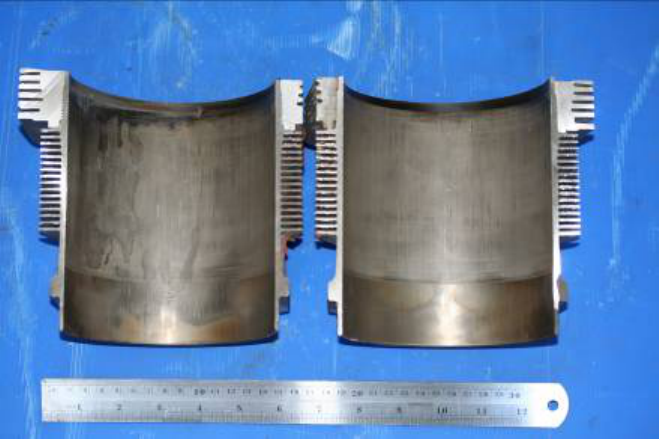
1.18 Additional Information
1.18.1 The Engine Teardown and Examination
1.18.1.1 Engine Teardown
The engine teardown was performed at the BIFA facilities in Buleleng, Bali, under
supervision of the NTSC investigators.
On the engine cylinder block #2, it was found that some scratches and de-lamination
of the coating materials on the inner side, and the piston crown discoloured.
1.18.1.2 Cylinder #2 Examination
The cylinder #2 was examined at the Laboratory of Metallurgy at the Institute of
Technology, Bandung.
From observations data, two main points that can be drawn are as follows:
• The coating de-lamination started earlier from the location near the TDC (Top
Dead Centre).
• Blisters were found on the coating. It suggested that foreign particles /
materials were presence on the cylinder liner surface before coating deposition.
It suggested also that the surface preparation during manufacturing was not
properly done.
Figure 4: De-lamination of coating.
10
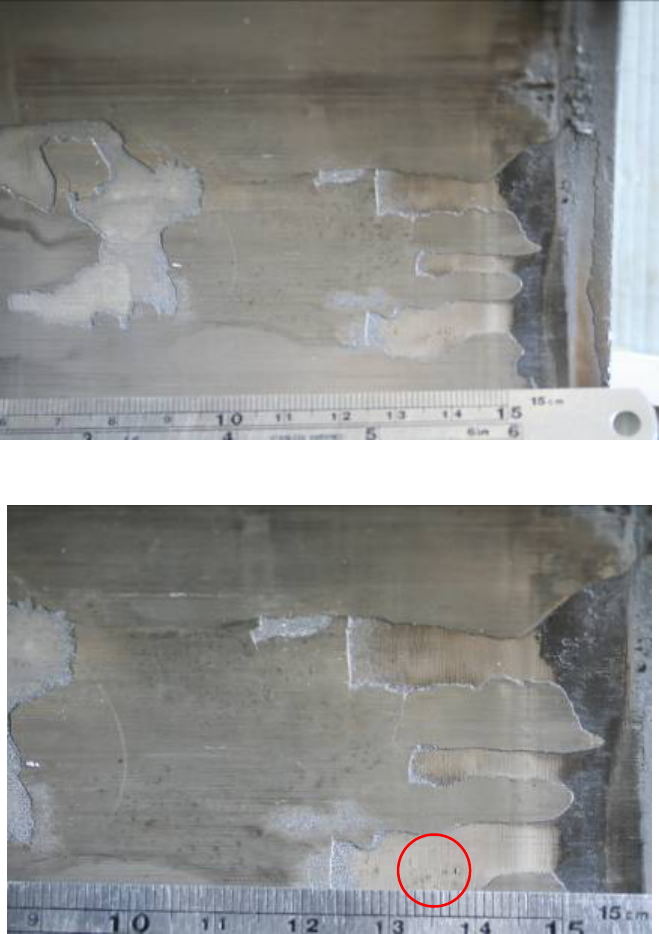
Figure 5: De-laminations started earlier from location near the TDC as indicated
Figure 6: The cylinder surface shows fine scratch lines which were intended to improve the
mechanical binding of the coating. A small metallic particle is observed at position near
13.7mm of the ruler
11
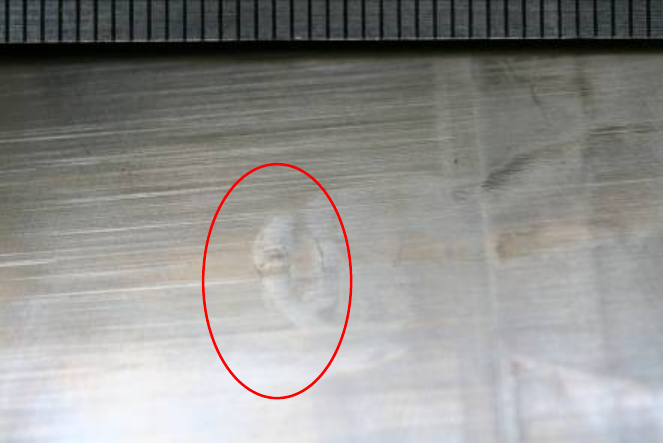
Figure 7: Blister of long type found near the BDC (Bottom Dead Centre). Cracks started to
develop at the blister
1.18.2 Maintenance
The Operator has altered the use of avgas to mobile gas with refer to the FAA
Supplemental Type Certificate (STC) number SE2587CE, at 26 August 2010 and
conducted a ground run and flight test. There was no engine setting changed required.
The Ignition Timing was set on 25
o
before Top Dead Center (TDC). There was also
information from another operator set the ignition timing on 23
o
before TDC for
Mobile Gas (Mogas).
The STC required that the minimum octane number to be used is 91. The fuel
laboratory test showed that the Mogas used had an octane number of 95.
1.18.3 Training Manual and Operation
The Training Manual
The investigation found one of the student pilots had qualified for solo flight, who has
not been trained for Emergency Procedure drill.
Refer to BIFA Training Procedure Manual, the Emergency Procedure drill should be
trained prior to first solo flight.
The Quality Control Section
Refer to BIFA Training Procedure Manual Chapter 2.2.2, responsibility of the Quality
Control section was to ensure that all training conducted by BIFA were in compliance
to all policies and procedures in the Training Procedure Manual and related CASR
(CASR Part 141, 61 and 91).
12
13
One of the Quality Control section duties was to carry out an internal audit and
surveillance at least once in every six months.
The investigation could not find any evidence of internal audit or surveillance
conducted by Quality Control section.
1.18.4 Fuel Handling Procedure
During the course of investigation, it was found that the mobile gas intended to be used
in the aircraft was transported to Blimbingsari base by a truck labelled “SOLAR” or
HSD (high-speed diesel). Furthermore, the aircraft fuel was stored in unsecured drums.
The fuel stored at Blimbingsari base were intended to be used for BIFA aircraft which
conduct training at Blimbingsari area which may required additional fuel. Normally,
the aircraft conducts training at Blimbingsari were carries sufficient fuel for the
duration of training from Buleleng.
1.19 Useful or Effective Investigation Techniques
The investigation is being conducted in accordance with the NTSC approved policies
and procedures, and in accordance with the standards and recommended practices of
Annex 13 to the Chicago Convention.

14
2 ANALYSIS
2.1 Engine Failure
The problem reported that the engine oil temperature was fluctuating, several moments
later; the engine temperature was steady at the top of the red band. The oil pressure
decreased slowly and the engine lost its power.
On the engine cylinder block #2, it was found that some scratches and de-lamination of
the coating materials on the cylinder liner, and the piston crown was discoloured (See
Appendix A).
Features of the damages on the cylinder liner #2 were as follows:
• The coating de-lamination started earlier from the location near the TDC (Top Dead
Centre).
• Blisters were found on the coating. It indicated that foreign particles / materials
were presence on the cylinder liner surface before coating deposition. It indicated
also that the surface preparation during manufacturing was not properly done.
The de-lamination of the cylinder liner decreased the engine power due to leakage of the
combustion gas into the crank-case. Consequently, the engine temperature increased, the
oil pressure decreased and the engine power decreased significantly and finally the
engine quit.
2.2 Fuel Alteration
The operator has altered the use of avgas to mobile gas with refer to the FAA
Supplemental Type Certificate (STC) number SE2587CE, at 26 August 2010 (1 hour
and 39 minutes prior to occurrence). There was no engine setting change required.
The STC required that the minimum octane number to be used is 91. The fuel laboratory
test showed that the Mobile gas used had an octane number of 95.
The fuel alteration was not a factor of the engine failure. If the fuel affected engine
performance, it should be observed during the ground run and flight test.
2.3 Fuel Handling Procedure
The method of transports Mogas fuel in the fuel truck that have been used to transport
any other type of fuel, may cause contamination to the aircraft Mogas fuel.
Storage of Mogas fuel in unsecured drums, may cause condensation and contamination.

15
3 CONCLUSIONS
3.1 Findings
• The instructor held a valid licenses and ratings for the operation of the aircraft.
• The aircraft was certified as being airworthy prior departure.
• The aircraft conducted a forced landing in a rice field and resulted the aircraft
landed in upside down position.
• The wing, landing gears, engine and propeller remained attached to the fuselage
wreckage.
• The Blimbingsari aerodrome Rescue and Fire Fighter Services were operated
during the search and rescue for this accident.
• The aircraft‘s engine oil pressure begun to drop below the green band and
continue drop to the red band.
• Pilot decided to discontinue the training and return to home base when the engine
oil temperature indication was steady at the top of the red band.
• The engine cylinder block #2 experienced de-lamination on the liner and over-
heated on the piston crown.
• The de-lamination of the coating of the cylinder #2 was caused by improper
manufacturing process, and accelerated by an excessive heat produced by the
detonation.
• The operator altered the use of avgas to mobile gas with refer to the FAA
Supplemental Type Certificate (STC) number SE2587CE, on 26 August 2010 (1
hour and 39 minutes prior to occurrence).
• The STC required that the minimum octane number to be used is 91. The fuel
laboratory test showed that the Mobile gas used had an octane number of 95.
There was no engine setting change required.
• The fuel alteration was not a factor of the engine failure. Had the fuel affected
engine performance, it should be observed during the ground run and flight test.
16
3.2 Causes
The problem reported that the engine oil temperature was fluctuating, several moments
later; the engine temperature was steady at the top of the red band. The oil pressure
decreased slowly and the engine lost its power.
The causes of the engine failure as follows:
• The engine cylinder block #2 experienced de-lamination on the liner and over-
heated on the piston crown;
• The de-lamination of the coating of the cylinder #2 was caused by improper
manufacturing process, and accelerated by an excessive heat produced by the
detonation.

17
4 SAFETY ACTIONS
After the accident, the NTSC issued some recommendation on Safety
Recommendations Letter No. KNKT/267/XI/REK/10 dated 23 November 2010 and
Letter No. KNKT/268/XI/REK/10 dated 24 November 2010.
4.1 Bali International Flight Academy
To response NTSC recommendation, Bali International Flight Academy had released
safety actions as follow:
a. Conducted one time inspection for all BIFA fleet related to the inner the inner wall
cylinder for the probability of scratch and delimitation;
b. Conducted one time inspection for all BIFA fleets related to fuel and air mixture
setting;
c. Temporarily stop usage of the mobile gasoline and re-use aviation gasoline;
d. Conducted recurrent training for maintenance engineers and mechanics, specific
for adjustment test and engine performance;
e. On December 2010, the BIFA changed their key management personnel, included
the Quality Control Section personnel.
4.2 Directorate General of Civil Aviation
To response NTSC recommendation, Directorate General of Civil Aviation had
released safety actions as follow:
a. On 27 December 2010, DGCA issued Safety Circular No. AU/10824/ DKUPPU/
5032/EK/V/XII/2010 related to Lycoming piston engine cylinder head inspection.
This Safety Circular instructs to all operators of Lycoming piston engine installed
cylinder assembly part number AE 65102, cylinder head part number AEL
85099IR to inspect the inner wall cylinder for the probability of scratch and
delimitation. The Safety Circular must be conduct by operator within 60 days, and
submit the inspection result to DGCA. At the time of issuing this Report, the
DGCA had not been informed of any discrepancies related to Lycoming piston
engine cylinder head inspection.
b. On 4 March 2011, DGCA issued Safety Circular No. No. AU/2088/
DKUPPU.1000/EK/VI/III/2011, related to Aircraft Fuel Storage, Handling and
Dispensing Procedure.
This Safety Circular instructs all operator to made or review their manual and
procedure about fuel storage, handling and dispensing procedure in according with
Staff Instruction 8300 Chapter 135 and Chapter 227, CAP 748, FAA Ac no.
150/5230-4A and ATA Specification 103.

18
5 SAFETY RECOMMENDATIONS
As a result of this investigation, the National Transportation Safety Committee issues
the following recommendations to address safety issues identified in this report
5.1 Recommendations to Bali International Flight Academy (BIFA)
The National Transportation Safety Committee recommends that the Bali International
Flight Academy (BIFA):
1. The emergency procedure training should be given to all student pilots prior to
first solo flight as described in the Training Procedure Manual;
2. Ensurred that the Quality Control section should performed the duty and
responsibility as described in the Training Procedure Manual;
3. Transportation of mobile gas fuel should be in the dedicated fuel truck and should
not be used to transport any other type of fuel. Fuel storage should be used secured
fuel drums.
5.2 Recommendation to the Director General of Civil Aviation (DGCA)
The National Transportation Safety Committee recommends that the Directorate
General Civil Aviation:
1. On 27 December 2010, DGCA issued Safety Circular No. AU/10824/ DKUPPU/
5032/EK/V/XII/2010 related to Lycoming piston engine cylinder head inspection.
This Safety Circular instructs to all operators of Lycoming piston engine installed
cylinder assembly part number AE 65102, cylinder head part number AEL
85099IR to inspect the inner wall cylinder for the probability of scratch and
delimitation. The Safety Circular must be conduct by operator within 60 days, and
submit the inspection result to DGCA;
2. On 4 March 2011, DGCA issued Safety Circular No. No. AU/2088/
DKUPPU.1000/EK/VI/III/2011, related to Aircraft Fuel Storage, Handling and
Dispensing Procedure. This Safety Circular instructs all operator to made or
review their manual and procedure about fuel storage, handling and dispensing
procedure in according with Staff Instruction 8300 Chapter 135 and Chapter 227,
CAP 748, FAA Ac no. 150/5230-4A and ATA Specification 103.
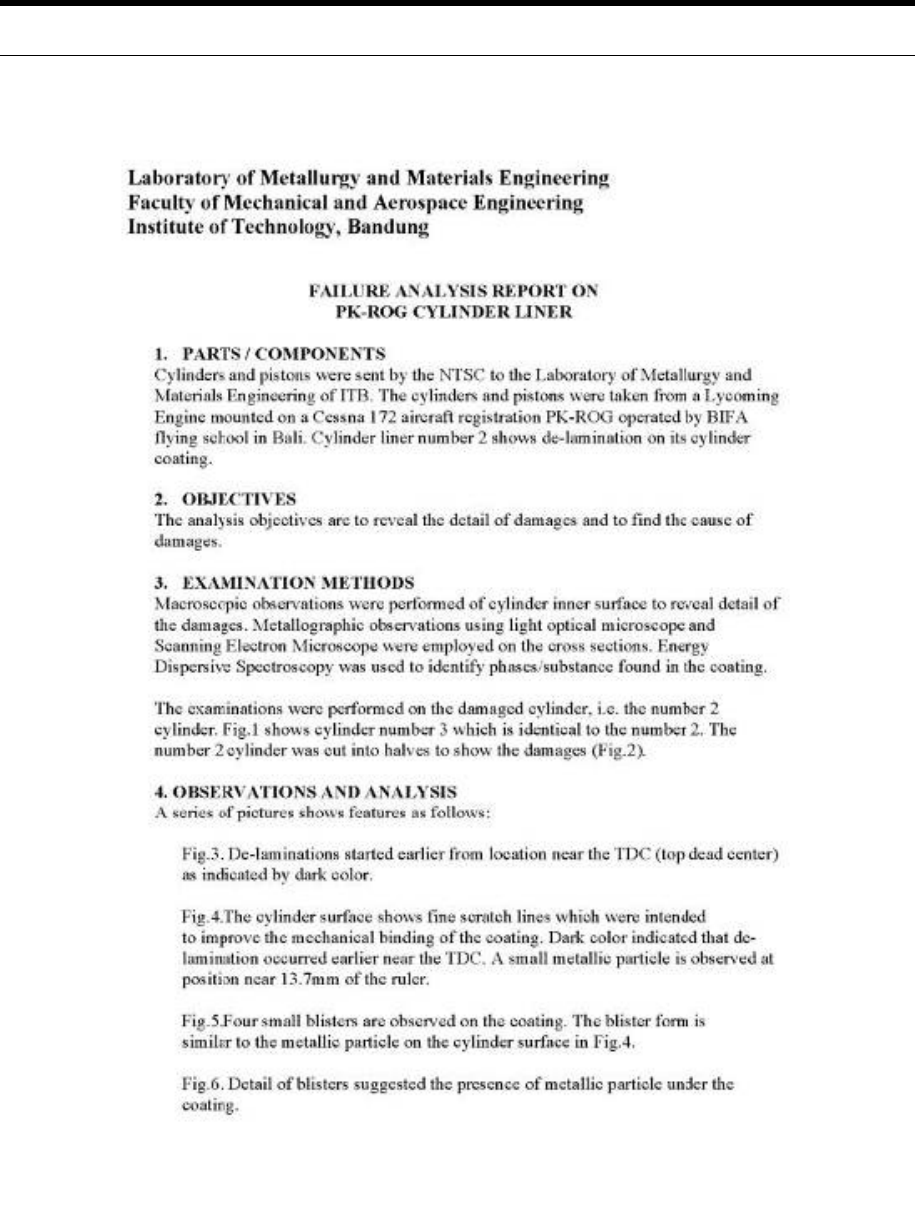
6 APPENDIX
Appendix A: Failure Analysis Reports on PK-ROG Cylinder Liner
19
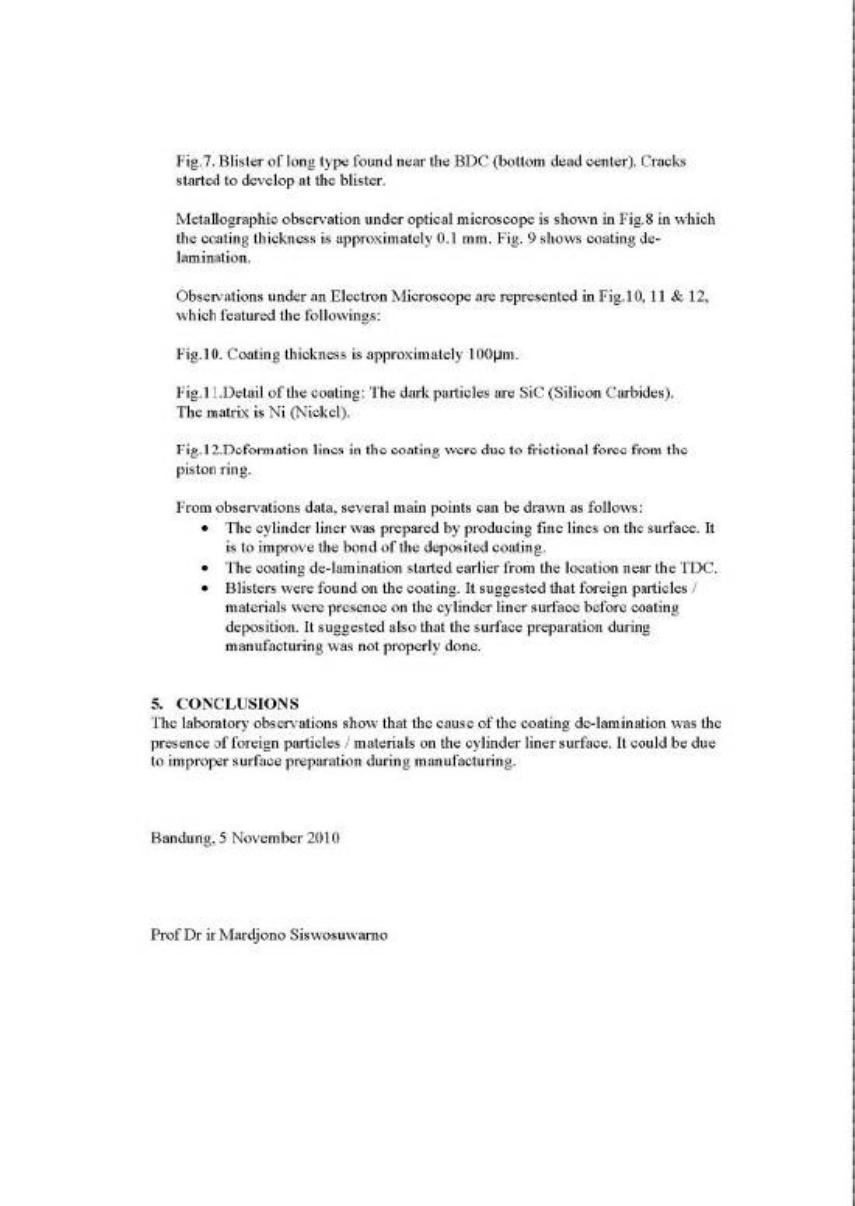
20

21
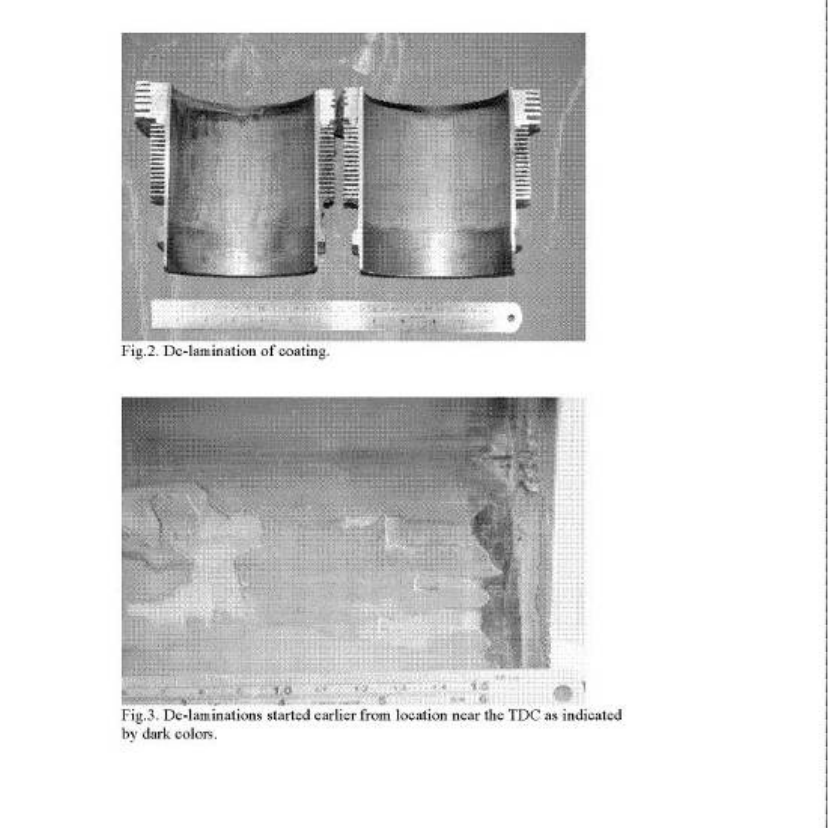
22
22

23
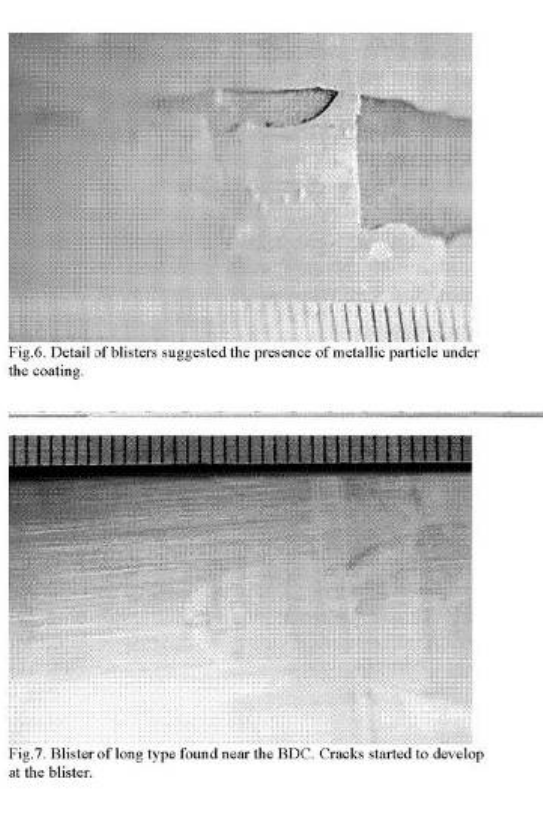
24
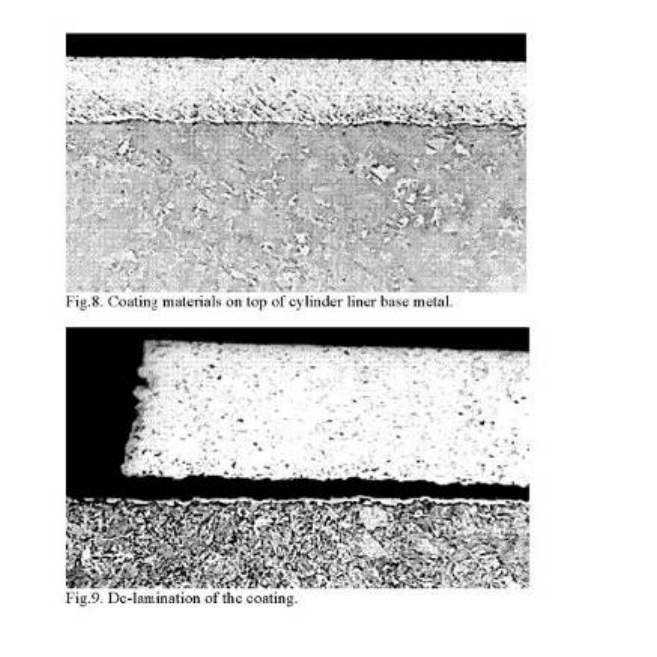
25
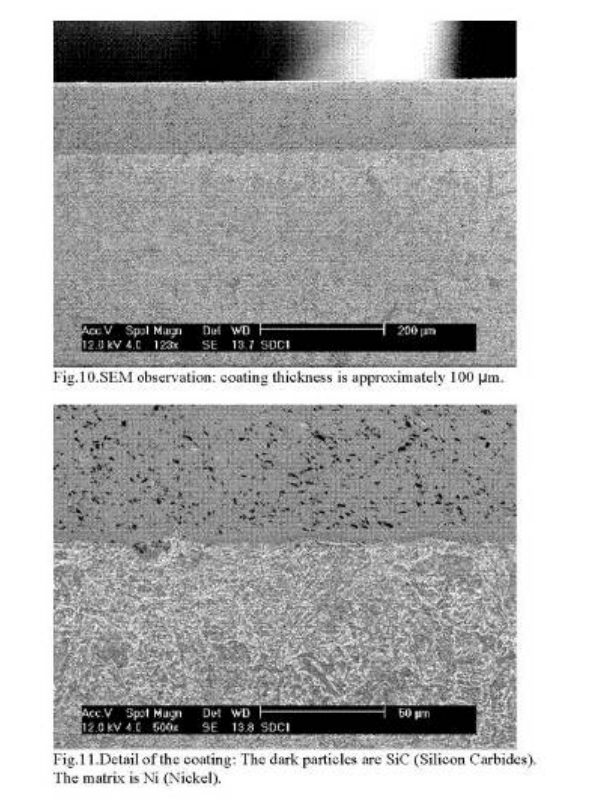
26
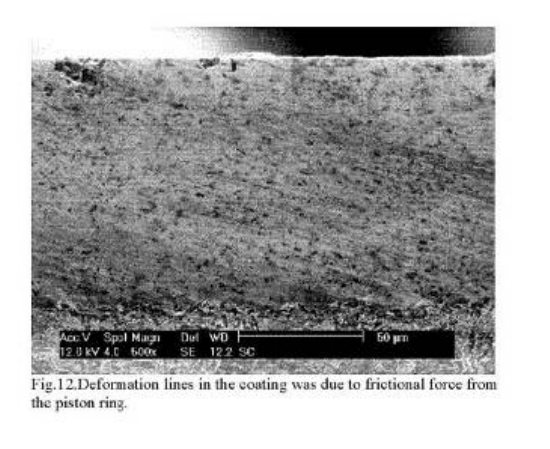
27
